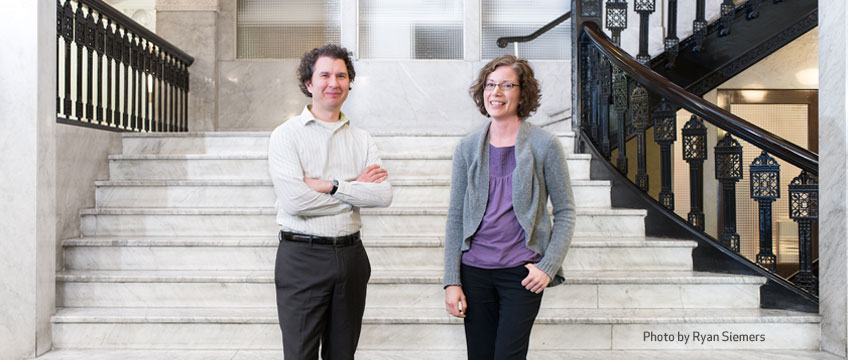Three Minnesota architecture firms—MSR, MacDonald & Mack, and Miller Dunwiddie—look to the future with a new generation of leadership
By John Reinan
When earlier generations of architects were ready to transition out of the firms they’d built, the process was sometimes handled, shall we say, rather briskly. “The previous owners just handed over the keys and that was it. It was kind of scary,” laughs Craig Lau, AIA, president of Miller Dunwiddie Architecture.
Now Lau and his partners are making their own transition, and they’re approaching it in a very different fashion. Three prominent Minneapolis firms—Miller Dunwiddie, MSR, and MacDonald & Mack Architects—are currently carrying out succession plans. In conversations with the outgoing and incoming partner generations at all three firms, a few key points became clear.
Succession planning is more complicated than the participants think it will be. It takes longer than expected, and it costs more. But in the end a thoughtful succession plan is the best way to preserve the skills, professional values, and brand identity that are at the heart of any successful practice. “The only thing that has value is our identity and our people,” says Tom Meyer, FAIA, a founding partner of MSR. “You could sell all the furniture and computers at our firm and maybe get enough for a used car. What people are buying into is a set of values that stands for something.
“If there have been pretty intense conversations,” Meyer continues, “they have been about that.”
He’s referring to dialogue he and his fellow founding principals—Jeffrey Scherer, FAIA, and Garth Rockcastle, FAIA—have had with the firm’s five new owners. Jack Poling, AIA, an MSR veteran of 24 years, was among the first group tapped to succeed the founders in 2000. But after several members of that group left the firm, the transition evolved. Poling says the founders deserve credit for sticking with their commitment to have the firm outlive them professionally.
“[That commitment] is a big deal,” says Poling, adding that there doesn’t seem to be a lot of knowledge in the profession about how best to handle succession. “I’ve had people from several other firms seek my opinion on transition.”
All of the firms interviewed for this article brought in consultants to help with planning. “It takes some dollars to do it,” says Stuart MacDonald, AIA, founding partner of preservation specialists MacDonald & Mack. “It involves attorneys; it involves insurance people, accountants, bankers. It involves your individual families. It’s just a pain in the neck.”
If the experiences of these firms are typical, succession is a deliberate process that could last anywhere from 3 years to 10 or more. “It’s like a rehabilitation project,” says Robert Mack, FAIA. “Everything takes longer and is more expensive than you expected.”
While the financial aspects of transferring ownership can be complex, both the old and new generations say they strove for a fair deal that didn’t place excessive burdens on the incoming partners. “That’s the part that’s taken the longest,” says Angela Wolf Scott, AIA, a new owner of MacDonald & Mack. Her colleague and next-generation partner Todd Grover, AIA, agrees. “There’s not a formulaic way of doing it,” he says. “We’re trying to make sure that Bob and Stu receive the legacy of what they’ve built, while not having it be a burden.”
At MSR, the financial side has been “very fair,” says new owner Josh Stowers, AIA. Adds Poling: “We set the value of shares so that it would be a commitment, but not so high that it would deter great young architects from wanting to be a part of the firm.”
And how were those young architects chosen? According to the outgoing generation, the choices were pretty clear. At Miller Dunwiddie, which is transitioning ownership to six younger principals, “I don’t think there was any surprise,” says John Mecum, AIA, principal and vice president. “We’ve recognized how these six have contributed to how the firm has moved through time. They took [knowledge] from us, but we also took from them.”
MacDonald says the seeds of succession were planted early, simply by virtue of choosing well among young job candidates. “We brought people on who had essentially the same interests in historic architecture, and who had a personality that meshed with the firm’s personality,” he says.
Indeed, the typical tenure of the incoming partners reveals the deliberate nature of these firms’ succession process. Nearly all of the younger leaders at the three firms have been with their organizations for more than 10 years—some for more than 20. Their architectural skills are finely honed, and so too are their skills in finance, project management, and client relations. They’ve gradually taken on more responsibility in their careers. Now, as they take over full ownership, they—and, just as important, their clients—are ready for it.
“As we’ve transitioned, the associate principals have taken on a greater role in writing proposals, drawing up fees, and so forth,” says Miller Dunwiddie principal Chuck Liddy, FAIA. “So the clients see these new faces while we’re still around, instead of just showing up for a meeting one day and we’re not there.”
The same story often plays out on the client side, says Daniel Green, AIA, an incoming owner. “Miller Dunwiddie has a history of long-term relationships with clients, some as long as 50 years,” says Green. “As we’re transitioning, these groups are transitioning as well. Young people we worked with 5 or 10 years ago are moving up.”
In many ways, transition planning is “another design problem,” says Paul May, AIA, an incoming Miller Dunwiddie owner. “We make time for it like any other project—break it into pieces and tackle it.”
MSR’s Meyer has a similar view. “Architects, for better or worse, think they can manage and design pretty much anything, whether it’s a presentation or a building or a process,” he says. “I think the three of us [founding partners] liked the process of doing this. It was another challenge.”
MSR’s younger owners don’t expect dramatic changes under their regime. “The daily operations are already out of the hands of the founders,” says Stowers. “We’re running the show, with their involvement. It’s certainly not a revolution—it’s an evolution.” Probably the main change, he says, is fewer meetings.
MacDonald & Mack’s Wolf Scott agrees. She and Grover participated in AIA Minnesota’s Leadership Forum, and one of the sessions focused on generational differences. “I kept trying to apply some of those generalities to the firm, and I had a really hard time fitting Bob and Stu into any of those boxes.” The major change initiated by the younger generation, she adds with a laugh, “was getting a coffee maker for the office that works.”
Perhaps the biggest challenge for the new generation of leadership is simply accepting the reality of being in charge, of having ultimate responsibility for the future of the business. Traci Engel Lesneski, an MSR partner since 2006, recounts a conversation at a company party. “We had gathered the whole staff and their families at a nature center,” she says. “And Jack [Poling] looked at me and said, ‘Do you know what your job is? Your job is to feed these people.’”
Adds Stowers: “I go to sleep every night worrying about two things: doing great work, and bringing in more work.”
But it’s a burden the younger leaders are ready to accept. “Our firm has always been like a family,” says Kathryn Hunsley, an incoming owner at Miller Dunwiddie. “We’ve all known each other for so long that, coming into this role, it’s been easy for us to work together.”
The older generation agrees. “What I’ve seen is that this group of six is now working more cohesively together,” says Mecum. “They understand and are moving forward on important aspects of management. It’s cool to watch them work together.”
“I think they’re a terrific group of people,” says Liddy. “And I have full faith and confidence that this firm will be around another 52 years.”



